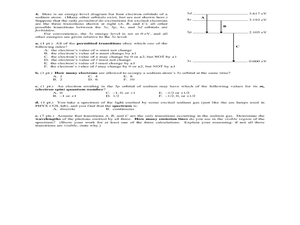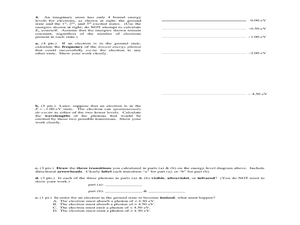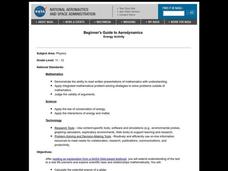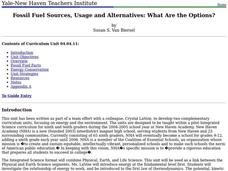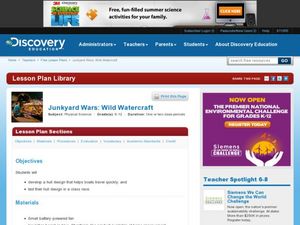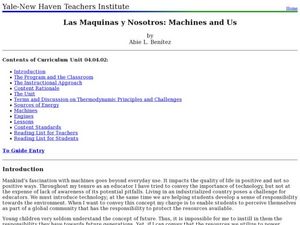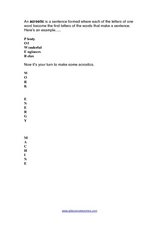Curated OER
How Solar Cells Work
Students create electricity. In this solar energy lesson, students role play how photovoltaic cells change sunlight into electricity. Students discuss the experiment and create their own diagram of the model.
Curated OER
Physics 152 Fall 2004 Final Exam, Parts A, B, C, D
At the end of a general physics course focused on light and electricity, you can administer this exam. Concepts covered include electromagnetism, circuits, induction, light rays, lenses and mirrors, characteristics of light, electron...
K12 Reader
Converting Energy to Motion
Combine science and reading skills with a reading comprehension exercise. Kids read four paragraphs about energy conversion and answer some reading comprehension questions about the information they have read.
Curated OER
Physics Final Exam, Part A
Here is a comprehensive and cohesive final exam for your high school physicists. A variety of question styles are incorporated, such as multiple-choice and problem-solving. Topics are too many to list, so you will want to review the exam...
Curated OER
The Physics of Toys
Students explore physics by experimenting with classic toys. In this physical science lesson, students utilize gliders, energy balls, bouncing balls, marbles and other toys to explore how they work. Students explore each toy at a work...
Curated OER
Energy Problem Set
Students calculate the potential energy of a glider, the kinetic energy of a moving glider and the change in velocity when potential energy changes to kinetic energy.
Curated OER
Kaleidoscope
Learners explore energy by creating a light project in class. In this kaleidoscope lesson, students discuss the properties of light and how mirrors can reflect the energy in different directions. Learners view a diagram of light...
Curated OER
Fossil Fuel Sources, Usage and Alternatives: What are the Options?
Students identify the different sources of fossil fuels. In this environmental science lesson plan, students research about how these impact our environment. They explore renewable energy sources that could replace fossil fuels.
Curated OER
Greenewables
Students form expert engineering teams working for the (fictional) alternative energy consulting firm, Greenewables, Inc. Each team specializes in a form of renewable energy used to generate electrical power: passive solar, solar...
Curated OER
Junkyard Wars: Wild Watercraft
Students develop a fast travelling hull for a boat. In this physical science lesson plan, the students' hulls will be tested in a channel (built by the teacher) with a fan as the driving force. The students will compete for who has the...
Curated OER
Conservation for the Ages
Students use the Internet to research a topic about energy conservation. They summarize the research information in an original studenT book and visit a local elementary school to present their projects.
Curated OER
Energy Forms
Learners explore energy by participating in a science lab in class. For this energy form lesson, students define the different types of energy such as light, mechanical and sound while examining energy measuring tools in class. Learners...
Curated OER
Unknown Element Project
Students work with a partner to determine the identity of an unknown element based on given descriptions. Groups use classroom textbooks, encyclopedias, and science internet sites to identify their unknown element then write a report as...
Curated OER
Hold Off on the Headphones
Students explore hearing loss caused by sound waves. In this physical science lesson plan, students will start by learning about waves and wave characteristics and move into sound waves. Students will study how sound effects their...
Curated OER
Las Maquinas y Nosotros: Machines and Us
Second graders explain the relationship between energy and work. In this technology lesson plan, 2nd graders describe the different uses of machines in their everyday lives. They record observations and data in their science journal.
ESL Kid Stuff
Parts of the Body
Eyes and ears and mouth and nose! Practice the names of body parts with a lesson based on the song "Head, Shoulders, Knees and Toes". Kids sing the song and read a story with the same vocabulary words before finishing a worksheet to...
Curated OER
Making Acrostics
In this making acrostics worksheet, 8th graders read the definition of an acrostic, read an example of one and write 3 acrostics using the words work, energy and machine.
Curated OER
Measuring the Speed of Light
Students explore physics by completing measurement problems in class. In this speed of light lesson, students discuss the importance of knowing the speed of light and how it affects many aspects of human life on Earth. Students identify...
Curated OER
Water and Ice: Part 1
Students observe the state changes in water. In this matter lesson, students observe, measure, and describe water as it changes state. Students explore how water can change from a solid to a liquid then back again. They journal their...
Curated OER
Discovery Science Library: The Basics Physical Science
Students examine friction and gravity. affect four sports. In this scientific discovery lesson, students examine how friction and gravity affect sports. They discuss, write, and illustrate the effect of different forces on various...
Curated OER
Water Power
Students observe a model of a waterwheel to investigate the transformations of energy involved in turning the blades of a hydro-turbine into work. They work as engineers to create a model for a new waterwheel while considering resources,...
Curated OER
Saudi Arabia -- Future city
Seventh graders summarize an article on Masdar. For this summarizing lesson students clearly explain three of the four points provided in an outline of the article. The students write an essay and identify six physical features of the...
Curated OER
The Human Memory
This is a well-designed, creative lesson to help young scholars learn more about the human memory. Working in pairs, students complete tasks and gather data. Excellent websites for resources are also provided.
K12 Reader
Charge It!
Electrify your pupils' interest in conductors and insulators with a brief reading passage! After reading the text, learners respond to five questions that relate to the content of the passage.

